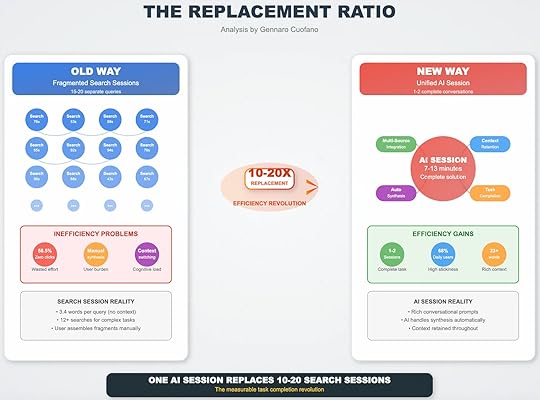The Replacement Ratio: How AI Collapses Search Into Synthesis

The internet was built on the ritual of search. You type a query, scan results, refine your wording, and repeat. Each task demands a chain of fragmented searches, scattered tabs, and mental stitching.
Now, that ritual is breaking. One AI session can replace 10–20 separate search queries. This is not just a usability upgrade — it’s an efficiency revolution that rewrites the economics of information.
The Old Way: Fragmented and InefficientTraditional search sessions follow a predictable pattern:
Short queries averaging 3–4 words, stripped of context.15–20 separate searches for a single complex task.Manual synthesis, where the user validates sources and reconciles contradictions.Context switching, bouncing between documentation, forums, and articles.The result is inefficiency at scale:
58.5% zero-clicks — wasted effort where queries produce no usable output.12+ queries per task, draining time and focus.A heavy cognitive load, as the user is forced to assemble fragments into solutions.The burden falls entirely on the user. Search engines provide fragments, not answers.
The New Way: Unified AI SessionsAI collapses this fragmented process into 1–2 unified sessions. Instead of typing 20 shallow queries, the user expresses a rich, conversational prompt — embedding intent, context, and goal.
In response, the AI handles what search never could:
Multi-Source Integration — pulling from varied knowledge pools simultaneously.Context Retention — remembering prior interactions in the conversation.Auto-Synthesis — merging fragments into coherent, actionable output.Task Completion — delivering not just information, but outcomes.One 7–13 minute AI session can accomplish what previously required half an hour of scattered searching and mental effort.
Quantifying the Replacement RatioThe shift is measurable.
1 AI session = 10–20 search queries.Efficiency gains of 3–4x, with faster outcomes and reduced cognitive overhead.Higher stickiness, with 68% of daily users returning to conversational systems.Richer context, as prompts average 23+ words instead of 3–4.The key insight: AI doesn’t just speed up search; it changes what “search” means. The function migrates from finding fragments to delivering synthesis.
From Fragmentation to FlowThink of the old search workflow as a broken assembly line. Each query is a piece, but the user is the factory stitching them into a finished product.
In the AI paradigm, the assembly line disappears. The user hands off intent, and the AI manufactures a complete solution.
Old Way: Input → Fragments → User Synthesis → OutcomeNew Way: Prompt → AI Synthesis → OutcomeThe user’s role shrinks from assembler to director. The value shifts from data access to task completion.
Why the Ratio MattersThe replacement ratio is not a technical curiosity. It’s a strategic signal of where value is migrating.
1. For UsersThe payoff is time and attention. Tasks that once consumed half an hour compress into conversational loops of under ten minutes. Cognitive load drops. Productivity rises.
2. For BusinessesThe SEO-driven game of visibility is eroding. When one AI session replaces 20 searches, fewer clicks flow to websites. The new challenge: being citable inside AI outputs, not just rankable in Google.
3. For PlatformsRevenue models built on click volume face pressure. If AI compresses search demand by an order of magnitude, advertising-driven economics must evolve toward verification, subscriptions, and task monetization.
The Efficiency RevolutionThe numbers crystallize the scale of change:
Old Session Reality: 12+ searches, 58% zero-clicks, user burden of synthesis.AI Session Reality: 1–2 conversations, context retention, automatic synthesis.This is not incremental improvement. It’s 10–20x efficiency.
Where search consumed effort, AI compounds efficiency. The “replacement ratio” quantifies the measurable productivity dividend unlocked by task unification.
Strategic TakeawaysDesign for Prompts, Not QueriesBusinesses must adapt content, products, and knowledge for AI-friendly synthesis. Structured data, clear context, and authoritative sources become the new visibility levers.Monitor Replacement Metrics
Track how many searches are being displaced by AI sessions in your workflows. The ratio is a leading indicator of disruption across industries.Shift to Task Value
Platforms will monetize not impressions but completed tasks — booking a table, generating code, making a purchase. Value creation follows completion, not clicks.The Paradigm Inversion
The replacement ratio captures the inversion at the heart of the AI era:
Search used to be about finding.AI sessions are about finishing.When one AI conversation can stand in for 20 search queries, the implications cascade across user behavior, business strategy, and platform economics.
This isn’t a UX upgrade. It’s the collapse of the search economy into the synthesis economy.
Final WordThe replacement ratio is more than a metric. It’s a lens into the future of digital interaction.
Every time a user trades 20 fragmented queries for one coherent AI session, the old web loses ground, and the AI-native web gains momentum.
One AI session replaces 10–20 searches. That is the measurable revolution.
The companies that understand this ratio — and design for it — will not just keep pace. They will define the next digital era.

The post The Replacement Ratio: How AI Collapses Search Into Synthesis appeared first on FourWeekMBA.



